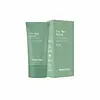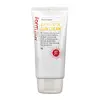What's inside
What's inside
 Key Ingredients
Key Ingredients

 Benefits
Benefits

 Concerns
Concerns

 Ingredients Side-by-side
Ingredients Side-by-side

Water
Skin ConditioningPropanediol
SolventHomosalate
Skin ConditioningButyloctyl Salicylate
Skin ConditioningEthylhexyl Salicylate
UV AbsorberCI 77891
Cosmetic ColorantDiethylamino Hydroxybenzoyl Hexyl Benzoate
UV FilterSilica
AbrasiveAcrylates Copolymer
Polysorbate 60
EmulsifyingGlyceryl Stearate
EmollientBeeswax
Emulsion StabilisingBis-Ethylhexyloxyphenol Methoxyphenyl Triazine
Skin ConditioningCetyl Dimethicone
EmollientSodium Stearoyl Lactylate
EmulsifyingPEG-100 Stearate
Caprylyl Glycol
EmollientC20-22 Alkyl Phosphate
EmulsifyingSorbitan Stearate
EmulsifyingAluminum Hydroxide
EmollientC20-22 Alcohols
Emulsion StabilisingPolyhydroxystearic Acid
EmulsifyingPortulaca Oleracea Extract
Skin ConditioningStearic Acid
CleansingParfum
MaskingXanthan Gum
EmulsifyingAcrylamide/Sodium Acryloyldimethyltaurate Copolymer
Emulsion Stabilising1,2-Hexanediol
Skin ConditioningTromethamine
BufferingSodium Polyacryloyldimethyl Taurate
Emulsion StabilisingIsohexadecane
EmollientBenzotriazolyl Dodecyl P-Cresol
UV AbsorberNeopentyl Glycol Diethylhexanoate
EmollientDisodium EDTA
Polysorbate 80
EmulsifyingPPG-17
Skin ConditioningSorbitan Oleate
EmulsifyingMelaleuca Alternifolia Leaf Extract
PerfumingLactose
HumectantCentella Asiatica Extract
CleansingPhenethyl Alcohol
MaskingWater, Propanediol, Homosalate, Butyloctyl Salicylate, Ethylhexyl Salicylate, CI 77891, Diethylamino Hydroxybenzoyl Hexyl Benzoate, Silica, Acrylates Copolymer, Polysorbate 60, Glyceryl Stearate, Beeswax, Bis-Ethylhexyloxyphenol Methoxyphenyl Triazine, Cetyl Dimethicone, Sodium Stearoyl Lactylate, PEG-100 Stearate, Caprylyl Glycol, C20-22 Alkyl Phosphate, Sorbitan Stearate, Aluminum Hydroxide, C20-22 Alcohols, Polyhydroxystearic Acid, Portulaca Oleracea Extract, Stearic Acid, Parfum, Xanthan Gum, Acrylamide/Sodium Acryloyldimethyltaurate Copolymer, 1,2-Hexanediol, Tromethamine, Sodium Polyacryloyldimethyl Taurate, Isohexadecane, Benzotriazolyl Dodecyl P-Cresol, Neopentyl Glycol Diethylhexanoate, Disodium EDTA, Polysorbate 80, PPG-17, Sorbitan Oleate, Melaleuca Alternifolia Leaf Extract, Lactose, Centella Asiatica Extract, Phenethyl Alcohol
Water
Skin ConditioningParaffinum Liquidum
EmollientEthylhexyl Methoxycinnamate
UV AbsorberCetearyl Alcohol
EmollientStearic Acid
CleansingGlyceryl Stearate
EmollientPEG-100 Stearate
Polysorbate 60
EmulsifyingTitanium Dioxide
Cosmetic ColorantBeeswax
Emulsion StabilisingGlyceryl Stearate Se
EmulsifyingDimethicone
EmollientTocopheryl Acetate
AntioxidantAscorbyl Palmitate
AntioxidantTriethanolamine
BufferingCarbomer
Emulsion StabilisingParfum
MaskingMethylparaben
PreservativePropylparaben
PreservativeDisodium EDTA
Water, Paraffinum Liquidum, Ethylhexyl Methoxycinnamate, Cetearyl Alcohol, Stearic Acid, Glyceryl Stearate, PEG-100 Stearate, Polysorbate 60, Titanium Dioxide, Beeswax, Glyceryl Stearate Se, Dimethicone, Tocopheryl Acetate, Ascorbyl Palmitate, Triethanolamine, Carbomer, Parfum, Methylparaben, Propylparaben, Disodium EDTA
Ingredients Explained
These ingredients are found in both products.
Ingredients higher up in an ingredient list are typically present in a larger amount.
Beeswax is natural wax produced by honey bees and can be synthetically created. It consists mainly of fatty acid esters and long-chain alcohols.
In cosmetics, beeswax is a emollient. Due to its waxy structure, it creates a protective barrier. This barrier prevents water from evaporating off the skin.
This may not be a good ingredient for oily skin. We recommend speaking with a professional if you have concerns.
Beeswax cannot be removed with water, but can be taken off with an oil cleanser.
Beeswax is also antiseptic and contains vitamin A.
Learn more about BeeswaxDisodium EDTA plays a role in making products more stable by aiding other preservatives.
It is a chelating agent, meaning it neutralizes metal ions that may be found in a product.
Disodium EDTA is a salt of edetic acid and is found to be safe in cosmetic ingredients.
Learn more about Disodium EDTAGlyceryl Stearate is a mix of glycerin and stearic acid.
It is used to stabilize the mixing of water and oil ingredients. By preventing these ingredients from separating, it can help elongate shelf life. It can also help thicken the product's texture.
As an emollient, it helps soften skin and supports barrier-replenishing ingredients.
In cosmetics, Glyceryl Stearate is often made from vegetable oils or synthetically produced.
This ingredient may not be fungal-acne safe
Fun fact: The human body also creates Glyceryl Stearate naturally.
Learn more about Glyceryl StearateParfum is a catch-all term for an ingredient or more that is used to give a scent to products.
Also called "fragrance", this ingredient can be a blend of hundreds of chemicals or plant oils. This means every product with "fragrance" or "parfum" in the ingredients list is a different mixture.
For instance, Habanolide is a proprietary trade name for a specific aroma chemical. When used as a fragrance ingredient in cosmetics, most aroma chemicals fall under the broad labeling category of “FRAGRANCE” or “PARFUM” according to EU and US regulations.
The term 'parfum' or 'fragrance' is not regulated in many countries. In many cases, it is up to the brand to define this term.
For instance, many brands choose to label themselves as "fragrance-free" because they are not using synthetic fragrances. However, their products may still contain ingredients such as essential oils that are considered a fragrance by INCI standards.
One example is Calendula flower extract. Calendula is an essential oil that still imparts a scent or 'fragrance'.
Depending on the blend, the ingredients in the mixture can cause allergies and sensitivities on the skin. Some ingredients that are known EU allergens include linalool and citronellol.
Parfum can also be used to mask or cover an unpleasant scent.
The bottom line is: not all fragrances/parfum/ingredients are created equally. If you are worried about fragrances, we recommend taking a closer look at an ingredient. And of course, we always recommend speaking with a professional.
Learn more about ParfumPeg-100 Stearate is an emollient and emulsifier. As an emollient, it helps keep skin soft by trapping moisture in. On the other hand, emulsifiers help prevent oil and water from separating in a product.
PEGS are a hydrophilic polyether compound . There are 100 ethylene oxide monomers in Peg-100 Stearate. Peg-100 Stearate is polyethylene glycol ester of stearic acid.
Polysorbate 60 is used to help stabilize products. It is a surfactant and emulsifier. These properties help keep ingredients together in a product. Surfactants help reduce surface tension between ingredients with different states, such as liquids and solids. Emulsifiers help prevent oils and waters from separating.
Polysorbate 60 is sorbitol-based and created from the ethoxylation of sorbitan. Ethoxylation is a chemical reaction used to add ethylene oxide. Sorbitan is a the dehydrated version of sorbitol, a sugar found in fruits.
In this case, the 60 comes from reacting 60 units of ethylene oxide with sorbitan.
Polysorbates are commonly used in medicine and foods.
Learn more about Polysorbate 60Stearic Acid is a fatty acid. It is an emollient, emulsifier, and texture enhancer.
As an emollient, stearic acid helps soften skin. It aids the skin's protective barrier by preventing water loss. It also provides a gentle cleansing effect without stripping away natural oils.
Stearic acid may also be used to enhance the texture of products. It can add volume and stabilize ingredients such as water and oil. This can help water and oil ingredients from separating.
Sources of stearic acid include animal or vegetable fats/oils such as coconut or shea. It can be naturally found in butter, cocoa butter, shea butter, vegetable fats, and animal tallow.
This ingredient may not be Malassezia folliculitis, or fungal-acne safe.
Learn more about Stearic AcidWater. It's the most common cosmetic ingredient of all. You'll usually see it at the top of ingredient lists, meaning that it makes up the largest part of the product.
So why is it so popular? Water most often acts as a solvent - this means that it helps dissolve other ingredients into the formulation.
You'll also recognize water as that liquid we all need to stay alive. If you see this, drink a glass of water. Stay hydrated!
Learn more about Water